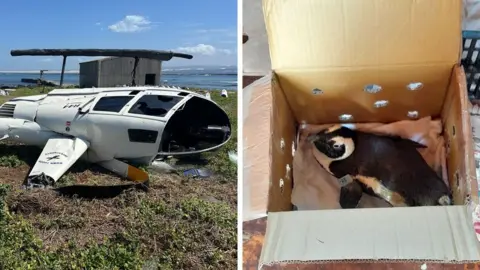In an unusual chain of events that left the aviation community stunned, an unsecured penguin was the cause of a helicopter crash in South Africa. This peculiar incident highlights not only the unpredictable nature of wildlife interactions but also the importance of ensuring strict safety measures in aviation.
A Photogenic Mission Gone Wrong
On the fateful day, a local wildlife conservation group had organized a helicopter flight to document and track the movement of endangered sea birds along the coast of South Africa. This ambitious project aimed to gather data crucial for both conservation efforts and educational purposes. The helicopter, operated by a well-respected aerial service, was equipped with state-of-the-art technology to capture aerial footage.
Among the team was a marine biologist who had temporarily transported a rescued penguin back to its natural habitat as part of a rehabilitation project. However, the penguin, affectionately named “Tux,” was unintentionally left unsecured in the helicopter’s cabin during transit. In an incredibly ironic turn of events, Tux’s presence would soon lead to catastrophe.
The Incident
As the helicopter ascended and began its intended flight path, Tux, blissfully unaware of the impending danger, began to move around inside the cabin. Wildlife experts noted that penguins are surprisingly agile and can shift their weight with ease. Due to the helicopter’s sudden maneuvers, Tux became agitated and started to flap his flippers, inadvertently hitting controls and causing a series of unintentional actions.
Within moments, the pilot struggled to regain control as the helicopter began to tilt and nosedive. Amidst the chaos, the pilot made a valiant effort to stabilize the aircraft, but the unexpected distraction proved overwhelming. It ultimately culminated in a crash landing on a nearby beach, fortunately avoiding residential areas and sparing additional lives.
The Aftermath
Emergency services responded swiftly to the incident. Miraculously, the pilot and crew emerged with only minor injuries, but Tux, unfortunately, did not survive the crash. Animal welfare organizations expressed their condolences over the loss of the penguin, while also recognizing the potential risks associated with transporting wildlife in aircraft without stringent safety protocols in place.
A subsequent investigation revealed that the helicopter had multiple safety features, including harnesses and cargo nets, designed to secure any transported animals. However, the crew had neglected to use these precautionary measures, underestimating the unpredictability of an unsecured animal in a confined space.
Lessons Learned
Aviation safety experts have since emphasized the significance of protocol adherence when transporting animals, regardless of their nature. Efforts have been initiated within wildlife organizations to reinforce training for pilots and crew members involved in wildlife transportation.
This bizarre incident serves as a crucial reminder that wildlife can often yield unpredictable results. It underscores the necessity of diligence and comprehensive safety measures when interacting with nature, particularly in environments where any disturbance could result in tragedy.
In conclusion, while the story of an unsecured penguin causing a helicopter crash might resemble something out of a farcical comedy, it holds tangible implications for wildlife conservation and aviation safety. As South Africa continues its commitment to protecting its unique fauna, ensuring the safety of both humans and animals will remain at the forefront of all conservation missions, keeping the wild — and the skies — a little safer for everyone involved.
Email Us on editorial@nnafrica.com













